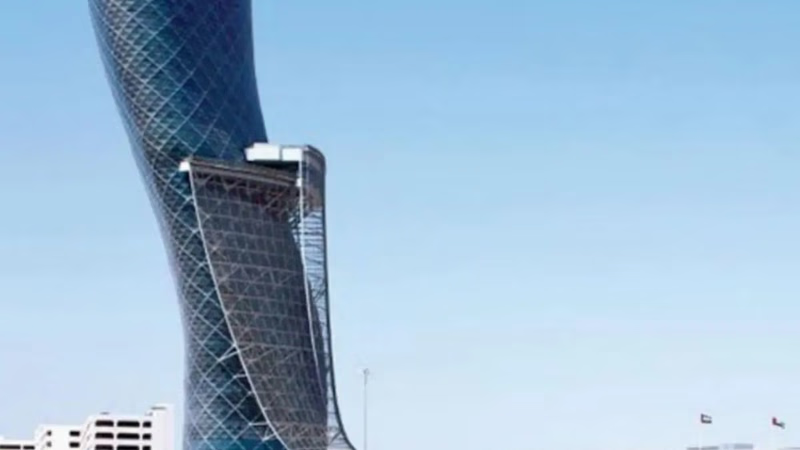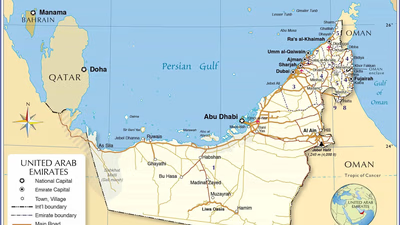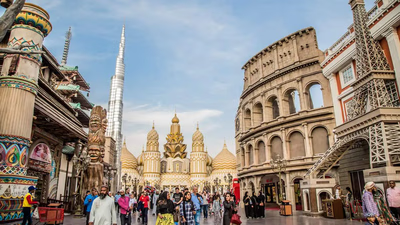
Discover Abu Dhabi"s architecture and Dubai"s skyline.
The capital of the United Arab Emirates (UAE) is Abu Dhabi. It is the largest emirate in terms of land area and serves as the political, administrative, and cultural center of the country. Abu Dhabi is located on the northeastern part of the Arabian Peninsula and is known for its stunning architecture, including the Sheikh Zayed Grand Mosque, Emirates Palace, and the Corniche waterfront. Located on the southeast coast of the Persian Gulf, Dubai is the most populous city in the UAE and a major global business and tourism hub. It is renowned for its impressive skyline, luxurious resorts, shopping malls, and iconic landmarks such as the Burj Khalifa (the tallest building in the world) and Palm Jumeirah.
Ras Al Khaimah is the northernmost emirate of the UAE and is characterized by its mountainous landscapes and sandy beaches. It offers a range of outdoor activities, including hiking, desert safaris, and water sports. Situated on the east coast of the UAE, Fujairah is known for its rugged mountains and pristine beaches. It is a popular destination for diving and snorkeling enthusiasts due to its abundant marine life and coral reefs. Each of these cities in the UAE has its own distinctive features, attractions, and economic significance, contributing to the overall diversity and development of the country.
Abu Dhabi is the capital of the United Arab Emirates and is considered to be the largest of the seven emirates in the UAE. Abu Dhabi covers an area of 67,340 square kilometers, which covers 86% of the UAE. It is located in the northern part of Abu Dhabi, the Persian Gulf. Abu Dhabi was declared the most expensive city in the world for travelers in 2009. According to the latest census, the area has a population of more than 1,500,000. Abu Dhabi has many functions, most of which are considered to be the islands of the Persian Gulf, and various cities and villages are also considered as other functions of this region, the most important of which are Al-Ain. List of commercial centers and hotels in UAE
- Ark Miracle
- World Village
- Dubai estuary
- Dubai Skiing
- Dubai Aquarium
- Sheikh Zayed Mosque
- Louvre Museum
- Jasmine Water Park
- Ferrari World
- Yas Mal
- Marina Mall
As we mentioned, the UAE consists of 7 regions, which are referred to as the cities of this country. In the following, we will provide you with explanations about each of these cities. As we said in the previous section, Abu Dhabi is the capital of the UAE and is the largest city in the country. Abu Dhabi covers an area of 67,340 square kilometers and is politically ruled by a constitutional monarchy. The Abu Dhabi region seceded from Britain on December 2, 1971. Dubai is also one of the most important cities in the UAE. A very important point to note is that the city of Dubai is only part of the Emirate of Dubai, and if Abu Dhabi is the largest emirate in Turkey, Dubai is the largest city in the UAE. Becomes. The city is located in the north of the UAE and is adjacent to the Persian Gulf. The area of this sheikhdom is 4114 square kilometers and its population is more than 4 million people.
Situated adjacent to Dubai, Sharjah is the third-largest emirate in the UAE. It is known for its rich cultural heritage and is recognized as the cultural capital of the Arab world. Sharjah is home to numerous museums, art galleries, and heritage sites. Located along the Persian Gulf coastline, Ajman is the smallest emirate in the UAE. It offers a mix of modern developments and traditional charm, with attractions like Ajman Museum, Ajman Marina, and beautiful beaches. Another small emirate, Umm al-Quwain is known for its natural beauty, including mangrove forests and sandy beaches. It also features historical sites such as the Umm Al Quwain Fort and the Old Harbor.
-

The United Arab Emirates (UAE) is a federation of seven emirates located in the Middle East, known for its significant oil reserves and economic diversification efforts. The country has transformed into a global business hub, with Dubai recognized for its tourism and architectural marvels. Abu Dhabi, the capital, features cultural landmarks like the Sheikh Zayed Grand Mosque. The UAE"s economy is bolstered by sectors such as finance, real estate, and renewable energy, attracting international companies due to its transparency and security. The multicultural society comprises both Emiratis and expatriates, with Arabic as the official language and English widely spoken in business contexts. The UAE"s strategic geographical location enhances its role in regional trade, making it a vital player in West Asia"s import-export activities. Hosting major events like Dubai Expo 2020 and international sports competitions further solidifies its status as a trade advertising platform. Understanding the UAE"s unique characteristics is essential for businesses looking to engage in commodity trade or supply chain solutions within the region.
-

The UAE"s economy has historically depended on oil and gas revenues, but significant efforts have been made to diversify into sectors like tourism, finance, and technology. The government aims to create a sustainable economy by reducing reliance on petroleum exports. Dubai stands out as a regional financial center with a robust logistics network that enhances global trade connectivity. Despite diversification, oil still plays a crucial role in the economy, particularly in Abu Dhabi. The UAE ranks among the top exporters and importers globally, with strong trade ties to countries like China and India. The tourism sector has become a major non-oil income source, supported by luxury hotels and extensive development projects. The UAE actively seeks foreign investment through favorable policies and free zones that offer tax exemptions and 100% foreign ownership. This openness has fostered an environment conducive to international business growth, making the UAE a key player in global trade. "
-

The UAE has established comprehensive laws and regulations for imports and exports to facilitate trade while ensuring public health and safety. Customs duties vary based on product type, origin, and trade agreements, necessitating consultation with the Federal Customs Authority for accurate tariff rates. The UAE adheres to international sanctions, requiring compliance from all traders. Free zones offer benefits like 100% foreign ownership and tax exemptions, but regulations differ across emirates. Businesses must secure valid commercial licenses and register with the UAE Customs Office to operate. The country has a high import rate, primarily in precious metals and machinery, with specific tariffs on goods like alcohol (50%) and tobacco (100%). The UAE"s efficient trade processes make it one of the easiest countries for import-export activities in the region. Compliance with health standards is crucial for food and agricultural imports, often requiring certifications or inspections.
Intellectual property laws are robust, necessitating respect for trademarks and copyrights in trade activities. Importers must also navigate documentation requirements for customs clearance, including invoices and permits. "
-

Dubai has emerged as a pivotal international trade hub in the Middle East, particularly for Iranian traders. Its strategic location, coupled with advanced port and airport facilities, facilitates efficient import and export operations. The city is known for its diverse export activities, including agricultural products like fruits and nuts, as well as handicrafts. Exports to Dubai can be conducted via air or sea, with the latter often utilizing traditional dinghy methods due to their cost-effectiveness and speed. This method is particularly favored for non-sensitive goods that can withstand exposure to water. Despite Dubai"s economic strength, its agricultural sector is limited, leading to a reliance on imports for most summer crops from countries like Iran and Turkey. The fruit market in Dubai has become especially lucrative for Iranian exporters, with watermelon and tomatoes being among the top exported items. Overall, the trade dynamics in Dubai highlight its role as a vital B2B marketplace in West Asia. "
-

The UAE"s population exceeds 9 million, with Emiratis constituting a small fraction. The majority are expatriates drawn from diverse regions, including South Asia, the Middle East, and Western countries. This demographic diversity is fueled by the UAE"s status as a global business hub, offering numerous job opportunities in sectors like construction, finance, and healthcare. The government provides Emirati citizens with social welfare benefits and public sector employment opportunities. The population dynamics are influenced by government policies aimed at balancing the native Emirati population with the expatriate workforce. As a result, the UAE ranks fifth globally in terms of being immigrant-friendly. The country is geographically located in the Middle East and consists of seven emirates: Abu Dhabi, Dubai, Sharjah, Ajman, Umm Al Quwain, Ras Al Khaimah, and Fujairah. Each emirate has unique characteristics that contribute to the overall economic landscape of the UAE. With ongoing changes in global conditions and local policies, the demographic composition of the UAE is expected to evolve further.
-

Abu Dhabi, the capital of the UAE, is the largest emirate and serves as the political and cultural hub. Known for its stunning architecture, it features landmarks like the Sheikh Zayed Grand Mosque and Emirates Palace. Dubai, the most populous city, is a global business center famous for its luxurious lifestyle and iconic structures such as Burj Khalifa. Other emirates like Ras Al Khaimah offer outdoor activities with mountainous landscapes, while Fujairah is popular for diving due to its rich marine life. Each emirate contributes uniquely to the UAE"s economic landscape, showcasing a blend of modernity and tradition. The UAE"s diverse cities enhance its appeal as a trade platform in West Asia, attracting both importers and exporters.






